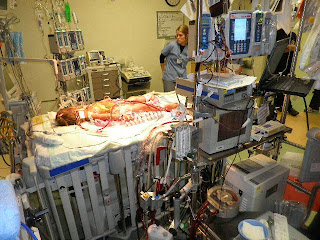A Heart Full of Love and Hope
One of our tiniest and most critically ill patients teaches us all a lesson of the human spirit
Alexis Cormier of Hazel Green, Alabama, was born with HLHS, a rare congenital heart defect in which the left side of the heart is severely underdeveloped. It stands for Hypoplastic Left Heart Syndrome. At age 3, she underwent a third surgery to help her symptoms, but after this complicated surgery, her entire heart was damaged beyond repair. She was immediately put on ECMO.
ECMO is a highly specialized treatment that stands for Extracorporeal Membrane Oxygenation. It is similar to a heart-lung machine and in effect, it removes the blood from the patient,
 |
| The tiny patient seen among her life saving equipment before the first air medical ECMO transport |
After being placed on ECMO, Alexis’ hospital in Memphis requested she be moved to Vanderbilt University Hospital in Nashville, and AirMed’s ECMO transport team was called into action.
Just four days after her first ECMO transport flight, it was decided that Alexis needed to be transported again, this time to UAB Hospital in Birmingham, Alabama, where she would receive a Berlin (artificial) heart.
Once more, the AirMed teams transported Alexis with their specialized ECMO equipment to UAB. This 3 year old who had struggled so much already in her short lifetime looked so small and helpless amidst all of the equipment. Her family held out for a miracle, but her will was strong and would not be denied.
Only four weeks later, members of the AirMed transport team traveled to UAB Hospital to find Alexis standing, smiling, brushing her teeth and splashing in the water at her hospital room sink. The only outward signs of any illness were a small feeding tube and two catheters under her clothing, connected at her lower abdomen. These catheters supply blood to her Berlin heart and return it to her circulatory system.
The Berlin heart device works by helping the right ventricle of the heart to pump blood to the lungs and the left ventricle to pump blood to the body. The bulk of the device is extracorporeal (outside the body); only the tubes are implanted. They emerge from small openings to enter the pump, a small round chamber, and the system is run by a laptop computer.
The Berlin heart device works by helping the right ventricle of the heart to pump blood to the lungs and the left ventricle to pump blood to the body. The bulk of the device is extracorporeal (outside the body); only the tubes are implanted. They emerge from small openings to enter the pump, a small round chamber, and the system is run by a laptop computer.
The Berlin Heart is intended to be used as a bridge to recovery or as a bridge to a transplant, which Alexis required. She was listed as 1-A on the nationwide heart recipient list, meaning she was among the top pediatric priorities.
Within a year, Alexis was undergoing a full blown heart transplant and now, in 2013, she is a thriving and active first grader.
Every one of us at AirMed International is grateful to be able to touch a life such as Alexis Cormier’s during our day to day duties.
Become an AirMed member and visit airmed.com.
Become an AirMed member and visit airmed.com.


No comments :
Post a Comment